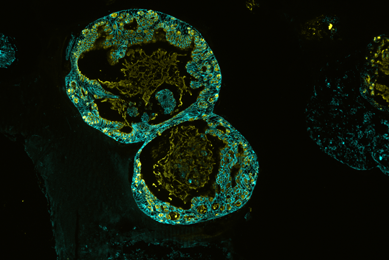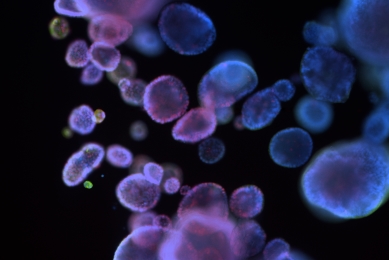Why it’s important
While organoids seem opaque and mysterious, this video animation gives us a look inside an organoid so that we can see them as the 3-D miniature models that they are.
The video starts in a simulated brightfield environment and slowly zooms toward the spherically-shaped organoids which are embedded in a gel matrix, represented by the fibers in the background. Next, we pan across organoids of various sizes, revealing the uneven texture of their surface. From there we travel into one organoid, and a cross section is revealed.
The image switches to immunofluorescence staining of several markers such as CDX2 in blue, ecadherin in red, and CK20 in green. The video zooms in further to identify Ki67 in pink and MUC5AC in yellow. Next, the animation goes to a cross section of the plasma membrane. Here we see tumor antigens such as PD-L1 and PD-l2 on the top, underneath we see intracellular signaling molecules such as RAS, FYN, SRC, PTEN, and others.
Organoid expert
Brian Shapiro, PhD
Marketing Segment Manager, Oncology, ATCC
Brian A Shapiro, PhD, works to communicate the scientific breakthroughs of ATCC’s product development laboratories to the biomedical research community. Brian is the Executive Producer of ATCC's Podcast, Behind the Biology. Previously, he worked at Virginia Commonwealth University, where he investigated the role of pre-mRNA splicing in the multi-drug resistance of lung cancer. Dr. Shapiro attended the Medical College of Georgia, where his research focused on adrenal physiology as well as diseases of the epidermis.
Go deeper in organoids and discover our tools for your research

Organoids
Patient-derived organoids are authenticated cell models paired with genomic and phenotypic data. Organoids are available from the Human Cancer Models Initiative (HCMI) and contribute to valuable and reproducible research.
More Culture guide
Culture guide
Organoid Culture Guide
Get expert guidance on growing and maintaining organoids from our organoid culture guide.
More
Organoid Growth Kits
ATCC CoreKits are packages of recombinant proteins, small molecules and other supplements designed to make the preparation of complex media formulations for select cell culture models easy and reliable.
More